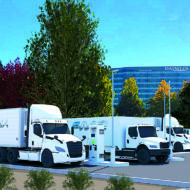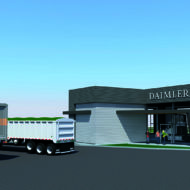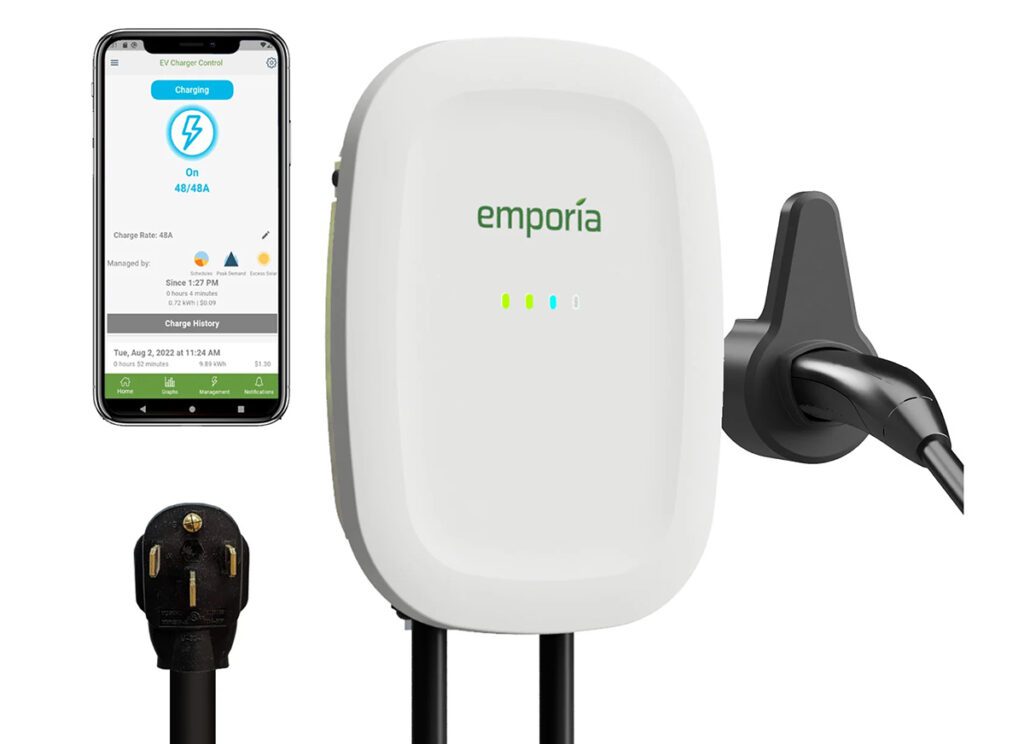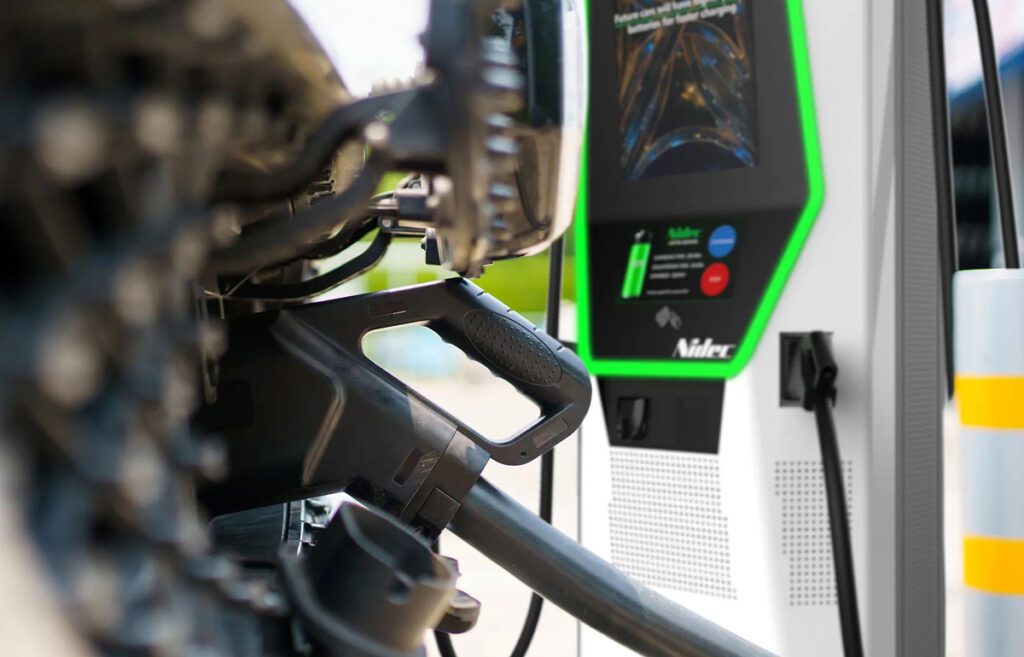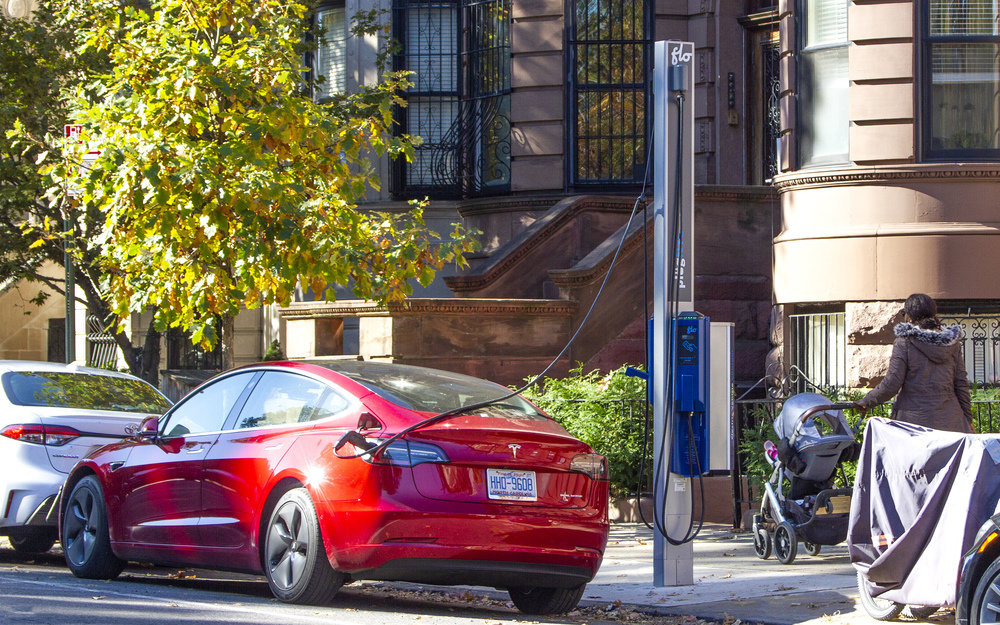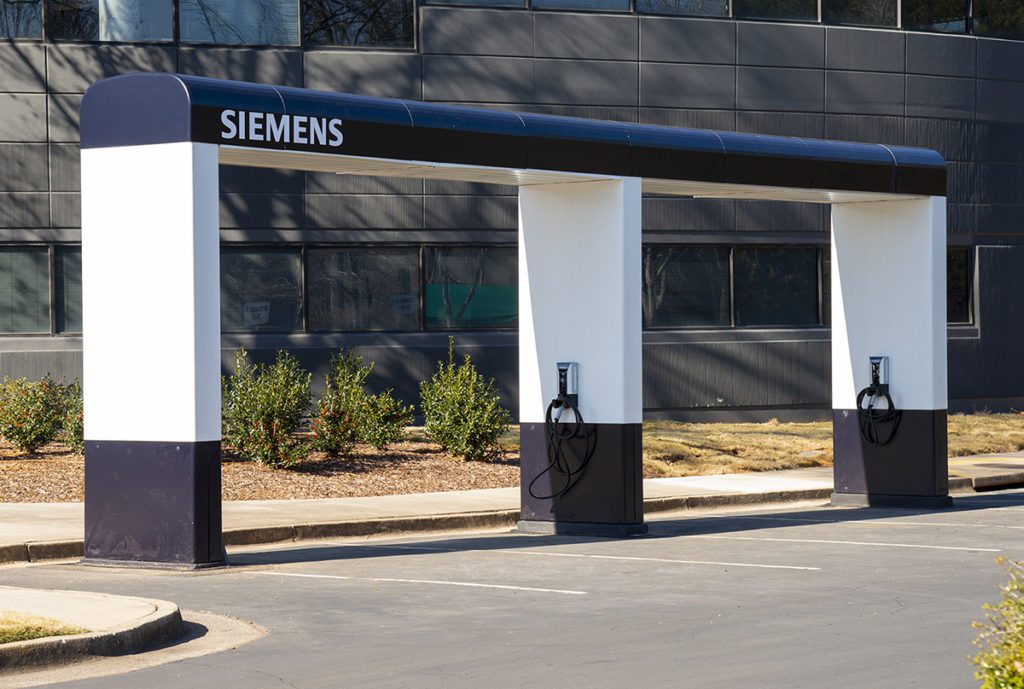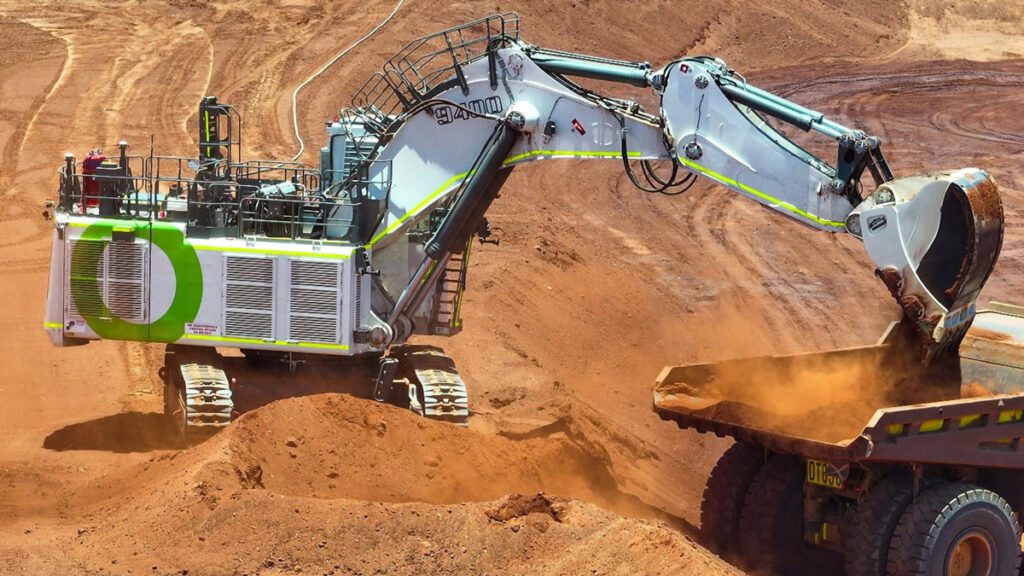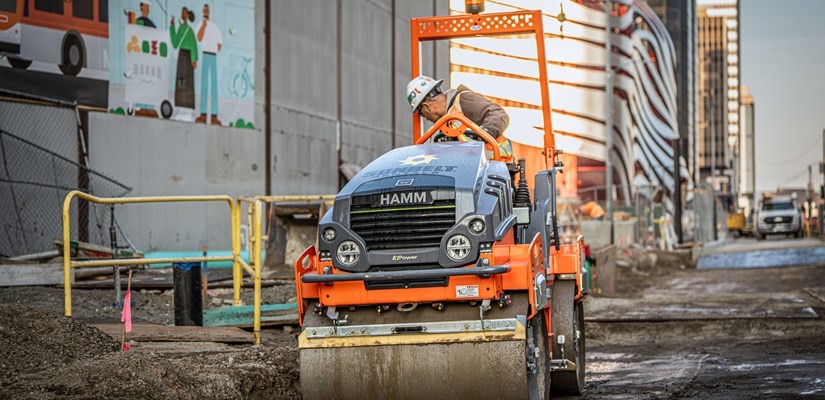The Electric Island project, a collaboration between Daimler Trucks North America and Portland General Electric, will be a test bed for all kinds of heavy-duty EV charging solutions.
Electric trucks are finally starting to roll. After years of vehicle development, research projects and pilot deployments, major fleet operators around the world are beginning to place volume orders for medium- and heavy-duty battery-electric vehicles.
More and more viable vehicles are coming on the market, from both established OEMs and bold startups. However, when it comes to charging infrastructure, there are still a lot of questions to be answered. Existing charging facilities designed for passenger vehicles are, to a large extent, unsuitable for commercial trucks—not only are power levels inadequate, but in most cases, the charging sites themselves simply aren’t designed to accommodate big rigs.
Furthermore, as many fleet operators are belatedly realizing, electrifying a fleet involves much more than simply installing a few charging stations. Operators are having to learn about things like load balancing, demand charge optimization and the emerging field of vehicle-to-grid (V2G) technology. Dealing with these issues requires specialized expertise, planning, and the involvement of the local utilities that are providing the “fuel.”
Vehicle manufacturers such as Proterra and third-party service providers such as Electrify Commercial, Enel X, and In-Charge Energy are responding to this need by offering turnkey infrastructure solutions to fleet customers.
Daimler is a major player in the emerging medium-and heavy-duty EV segment. In North America, its commercial vehicle subsidiary, Daimler Trucks North America, has multiple EVs on offer, including the Thomas Built Bus all-electric school bus, Jouley, which is now in production, and the Freightliner Custom Chassis Corp (FCCC) MT50e walk-in van chassis, which is expected to launch this year. Under its Freightliner brand, the company currently has 40 Class 8 eCascadia and Class 6-7 eM2 electric trucks in pilot operation with more than 20 fleet operators, and both trucks are scheduled to begin limited production in 2022. In Europe, Daimler’s eCitaro electric bus and the Fuso eCanter Class 4 van are both in production. The Mercedes-Benz eActros, a heavy-duty truck aimed at the urban delivery market, is undergoing real-world testing, and is slated for production later this year.
Portland General Electric (PGE) is Oregon’s largest electric utility, serving approximately 900,000 customers in 51 cities. PGE has long been a leader in transportation electrification, helping accelerate the use of electricity as a transportation fuel in its service area through innovative pilots and programs. PGE programs include the Electric Avenue public fast charging network, technical outreach and education services, and rebates for residential customers for the installation of connected charging infrastructure.
Rustam Kocher is the Charging Infrastructure Lead at Daimler Trucks North America, and also the Chair of CharIN’s Megawatt Charging System (MCS) task force, which is working to develop a new fast charging standard for heavy-duty vehicles. Joe Colett is a Transportation Electrification Engineer on the Grid Edge Solutions Team for Portland General Electric (PGE).
The first phase, slated to open early in 2021, will feature nine chargers, which will be used to test the one-megawatt charging capability that the MCS task force is developing.
Charged recently chatted with Kocher and Colett to learn more about the Electric Island project the companies recently announced. The first phase, slated to open early in 2021, will feature nine chargers, which will be used to test the one-megawatt charging capability that the MCS task force is developing. Phase two of the project will add on-site energy generation, storage, and a technology showcase building.
Charged: We are hearing a lot lately about smart charging services for fleets. Fleet customers are buying EVs and it’s slowly dawning on them that they can’t just buy some chargers and plug in. They need help, they need services like load balancing and demand charge management. What do you see as the biggest unknowns for fleet customers that this project will help to solve?
Kocher: This Electric Island project is as much a learning site about hardware as it is about software and management of those resources together. We’ll have on-site generation, storage and charging, so obviously you need control software to be able to manage those aspects together, as well as the management of the charging with the trucks. For instance, we’ve got a couple of paired chargers on the site, where we’ll be able to manage sequential charging, so when one truck has finished or almost finished, the charge can be switched over to the other truck. We want to offer those resources and services to our customers, and this is a place for us to refine those before we roll them out.
Colett: This is a gap we’re also seeing among all kinds of different fleet operators right now. As a utility—really an electric fuel provider—it’s a gap we’re very interested in addressing, so we’re doing a number of things on this front. We have some new programs in front of our regulators right now to address some of the infrastructure build-out—for example, the utility interconnection, as well as the electrical and civil infrastructure needed to install a charging station. We call that “make-ready,” and we’ve gone in front of our regulators and said, we’d like to actually build, own and operate this for our customers, so all they have to think about is purchasing a charging station, taking a lot of the costs and a lot of the friction out of transitioning to using electricity as a fuel. So it’s a gap we see and as a utility, we feel that we can help address as well.
Kocher: Demand response becomes really important for the utility as well, so the software will be integrated to respond to signals from the utility. For example, if we’re having a super-hot day in Portland and everybody’s got their air conditioning on and PGE is tapped out, they’re not going to want trucks to be able to come in and charge at the highest rate possible. So we’ve got to be able to respond to those signals at the site.
Colett: This is also a software test bed where we’re doing a lot of work on how these technologies work together. When the grid is congested or energy prices are very high, can we send a signal to have the energy storage system take over some of that charging demand, to lower the site’s impact on the grid? Can we lower charging rates? Some of it is technical feasibility, getting all these systems to talk to each other, but some of it’s also customer experience. What would a freight customer find acceptable, or what would be the best way for them to participate in these events? Through compensation, or by having their charging sessions curtailed? Or maybe they really need the option to override, for example, if they’re going to earn a lot more money delivering that freight than participating in the event. So there’s a lot of great research that can be done on that front as well.
Charged: This Electric Island sounds like it’s going to need a lot of power. Can you tell us a little more about the mix of on-site generation and storage capacity that you’re planning?
Colett: The backbone of this site is a connection to the utility distribution network, our distribution network, that can handle up to five megawatts, and we’ve done that through two 3,000-amp services and 2,500 kVA transformers. But we also spent a lot of time in the design phase, making sure that other technologies will be able to be deployed here. A photovoltaic array will likely be sited on the roof of the building. This isn’t going to be a utility-scale installation, this is something on the order of 30 kilowatts, but it’s really important for us as a learning tool, as it interacts with the other technologies at the site to help us learn how to integrate it for future, potentially larger deployments of on-site generation.
We’ve also designed our electrical services, all the equipment pads and the whole site layout to enable the installation of up to half a megawatt-hour of on-site storage, so that trio of resources will be able to interact with the chargers and provide energy for the charging sessions.
The idea is to understand the interplay between technologies and how all of these can be used together to make sure that really high-speed charging rates are interacting with the grid in a beneficial way.
The idea is to understand the interplay between technologies and how all of these can be used together to make sure that really high-speed charging rates are interacting with the grid in a beneficial way.
Charged: If we think about a truck stop that’s going to need a lot of power, are there any existing industrial applications that are comparable in terms of load profiles, power needs, etc. that you can learn from and borrow technology from, or is this a totally new sort of thing to deal with?
Colett: It’s a really interesting question from a utility perspective, because in some ways new load is new load, whether you’re a data center, an office building or a factory. However, in some ways this load is pretty unique because of the intermittent way that these charging sessions occur, and because of their potential location at a fueling station on the side of a highway, which might be a pretty different place to serve versus an industrial park where grid infrastructure would look different.
That’s why we’re so interested in this demonstration project, because we get to learn a lot more about what those loads look like, and it’ll help us prepare for that future. But I’ll also say that, generally speaking, we’re very comfortable serving the load. Every day we’re meeting our customers’ needs in terms of what we’re able to plan for and deliver, that new energy, so we’re confident about our ability to do that in the future as well.
Kocher: That’s part of the learning from this site. We’ll get a better view of what this demand curve looks like. The West Coast Clean Transit Corridor Initiative is a research study that was recently done by [engineering firm] HDR (www.westcoastcleantransit.com). They ran a study up and down the I-5 corridor to find out where the conjunction of 70-mile jumps with available land and available power from the grid could potentially be made. They were pretty excited [about the Electric Island project] because this will take one of the dots off that map, because we’ll have filled that need. It’s kind of exciting to be the first [charging site] on the map as it were.
Charged: When we’re talking about providing this kind of charging solution to fleet customers, it sounds like this is something that the utility needs to be a partner in also.
Colett:Yeah, I think it’s especially important as we get into the charging rates necessary to keep our medium- and heavy-duty vehicles fueling quickly the way they need to, to keep them on the road and making money for their operators. We’re talking about multi-megawatt new loads showing up in different areas on the grid, so it’s really important for us to be engaged with our customers early. Some of those new loads just take a little bit more time for us to build out infrastructure and serve. So utility involvement in this phase is critical.
Charged: This is starting to sound a bit complicated for an OEM like Daimler. How many hundreds of local utilities are there just in the US?
Kocher: Well, that happens to be one of the hats that I wear. In addition to managing [our side of Electric Island] and leading the MCS project, one of the job titles I have with the ecosystem team is the single point of contact with the utilities, so it’s my job to reach out to them, explain to them what we’re doing and how we’re moving into electrification, and what role they play in providing that service to our common customers.
Charged: Tell us more about the one-megawatt charging standard that’s in development.
Kocher:I’m actually the leader, through the organization called CharlN, on the development of this megawatt charging standard. It’s a global endeavor—we’ve got over a hundred, and closing in on about 120, members of CharlN who are involved in this process. They encompass OEMs, utilities, EVSE manufacturers and the like, and we’re working to establish this megawatt charging standard as the new commercial vehicle charging standard globally. It will not only be applicable to rolling vehicles, but also to aviation and marine, who’ve taken quite an interest in it.
Charged: What charging system are your Daimler medium- and heavy-duty vehicles using now?
Kocher: Today it’s CCS1 for the US market, and we have the Mercedes Benz eActros In Europe that is using CCS2.
Charged: How does the new MCS compare technically to the existing CCS?
Kocher: The CCS, as it stands today, is limited by the literal size of the connector, and its ability to conduct the power you need to fast-charge a commercial truck. The biggest battery pack in a passenger car out there today is about 100 kWh. Well, these trucks are carrying 400, 500 kWh, in some cases more, on board. And if we want to fast-charge that truck, if we want to turn it around in 20 minutes so that another user can use it for another eight hours, which a lot of truck fleets do, you need a lot more power across that connection point than you can do with CCS1 or CCS2 or even CHAdeMO today. So, we came together to find how we can define that connection and be able to conduct that amount of power to truly fast-charge the truck.
If we want to fast-charge that truck, if we want to turn it around in 20 minutes… you need a lot more power across that connection point than you can do with CCS1 or CCS2 or even CHAdeMO today.
We felt that it was really important to bring a lot of voices to the table, so we could fully describe the problem from all the different aspects. So, we have utilities on board, we have customers that are very involved in this process, we’re involved with the testing agencies, the truck manufacturers, the EVSE manufacturers, the cord and cable and connector manufacturers—everybody’s come together to help define what the problems are and how we can best overcome them. We’re two years into the project, and we will have a design that we’re able to reveal sometime this year. We held a testing event at the National Renewable Energy Laboratory in Golden, Colorado in September, and we’re planning on a second one here, probably in February, where we take the learnings from that event, we’ve applied them to the design, we’ll test it again, and hopefully by then, we’ll be able to reveal the connector and the inlet to everyone.
It is going to be different than CCS, because from a safety perspective, it’s going to have different requirements for a number of different aspects of the charging stations. Initially we were hoping that you could simply take the connector and cable off an existing CCS charger, swap it out for the MCS connectors and be good to go, but because of the amount of power that we’re going to conduct across this, it’s going to require new equipment.
Hopefully it’s not substantially different equipment, but obviously we’re putting a lot more power through it, so in the end, [EVSE manufacturers] are going to build new equipment for this, and we’re okay with that because—and this was part of this process—when we look at available charging infrastructure for trucks today, only about 0.1% of charging is even accessible to commercial trucks.
In other words, does it fit? Can you take the truck in and charge it? You have scenarios like this: yes, the truck fits, but it doesn’t really, and you have to drop the trailer to do it, and you’re blocking all the other parking in the lot, and in many cases, you’re so heavy that you’re causing damage to the site or things like that. So, we feel okay with the fact that new equipment is going to have to be required to support these vehicles, because there’s currently nothing available out there, so it’s all going to be new install anyway.
It’ll have to be integrated with travel plazas and sites like that, and that’s where our partnership with PGE for the Electric Island is really important. We can come up with solutions for how the trucks move on the site, and we’ll be able to recommend that to folks as they roll out this infrastructure.
Colett: That’s another aspect that is unique about Electric Island—this site was really designed for Class 8 vehicles towing a trailer. From the beginning, we’ve done the traffic studies, and we were very careful about how the islands were laid out.
Charged: Does MCS involve a liquid-cooled cable?
Kocher: It can—especially at the higher powers, it most likely will. However, we’re not going to require it. Part of the testing we ran at NREL was ambient air-cooled, without any direct cooling, and we were able to achieve…high amperage across those connections and meet the temperature requirements. And the liquid-cooled [equipment] we were really happy with as well. So, all we’re going to do is put out the temperature requirements that currently exist according to cable connection standards today, and require that people meet those temperature standards. And in order to do that at the high amperage levels, there’ll have to be some sort of direct cooling solution provided.
If you’re a fleet owner, you’re not always going to quick-charge. It’s just like your [passenger car] that has the CHAdeMO or the J1772 on it. You use the CHAdeMO when you need to, but most of the time you use the J1772. So it’s entirely plausible, if you have some sort of an overnight charge, it’s also on MCS, but at a lower power. You can easily put 30 amps over [the MCS connector], or 3,000 amps.
I lived through the standards wars in the early 2010s, and I wanted to make sure that didn’t happen on the commercial side.
Charged: It sounds like you have a lot of players on board for MCS. Is this looking like the new standard, or are there some competing standards in development?
Kocher: That’s the hope. We are saying this is a global charging standard for commercial trucks. CHAdeMO and GB/T are working on their shared standard, but the published limits that they’ve put out are going to be below what we’re going to be capable of from a safety and performance standpoint.
This is the only reason I got involved, to help avoid competing standards. I lived through the [CCS vs CHAdeMO] standards wars in the early 2010s, and I wanted to make sure that didn’t happen on the commercial side.
This article appeared in Charged Issue 53 – January/February 2021 – Subscribe now.




